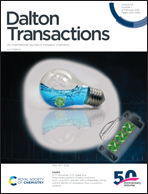Characterizing the solid hydrolysis product, UF4(H2O)2.5, generated from neat water reactions with UF4 at room temperature†
Abstract
Uranium tetrafluoride (UF4) is an important intermediate in the production of UF6 and uranium metal. Room temperature hydrolysis of UF4 was investigated using a combination of Fluorine-19 nuclear magnetic resonance spectroscopy (19F NMR), Raman and infrared spectroscopy, powder X-ray diffraction, and microscopy measurements. UF4(H2O)2.5 was identified as the primary solid hydrolysis product when anhydrous UF4 was stirred in deionized water. Static NMR and 19F magic angle spinning NMR measurements revealed that a small amount of uranyl fluoride can also form when anhydrous UF4 is left in water, although this species comprises less than 5% of the total sample with the remaining parts being UF4(H2O)2.5. Since UF4 is generally considered to be stable under ambient conditions, these findings mark the first time that a room temperature reaction between UF4 and water has been detected and analyzed without interference from additional chemical reagents. The Raman characterization of UF4(H2O)2.5 presented herein is the first on record. Since UF4 is one of the most used intermediates during chemical conversion of uranium ore to uranium metal for nuclear fuel and weapons, the results presented herein are applicable to numerous nuclear science fields where solid state detection of uranium is of value, including nuclear nonproliferation, nuclear forensics, and environmental remediation.



 Please wait while we load your content...
Please wait while we load your content...